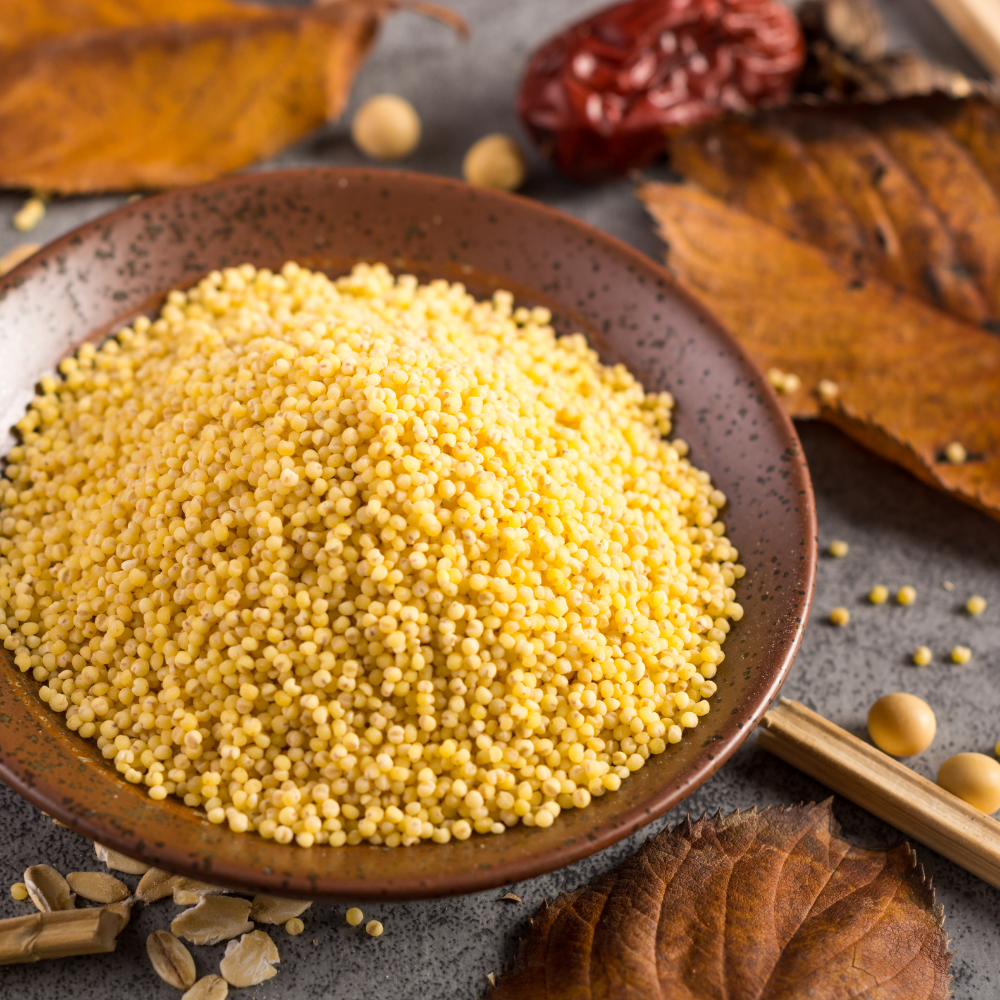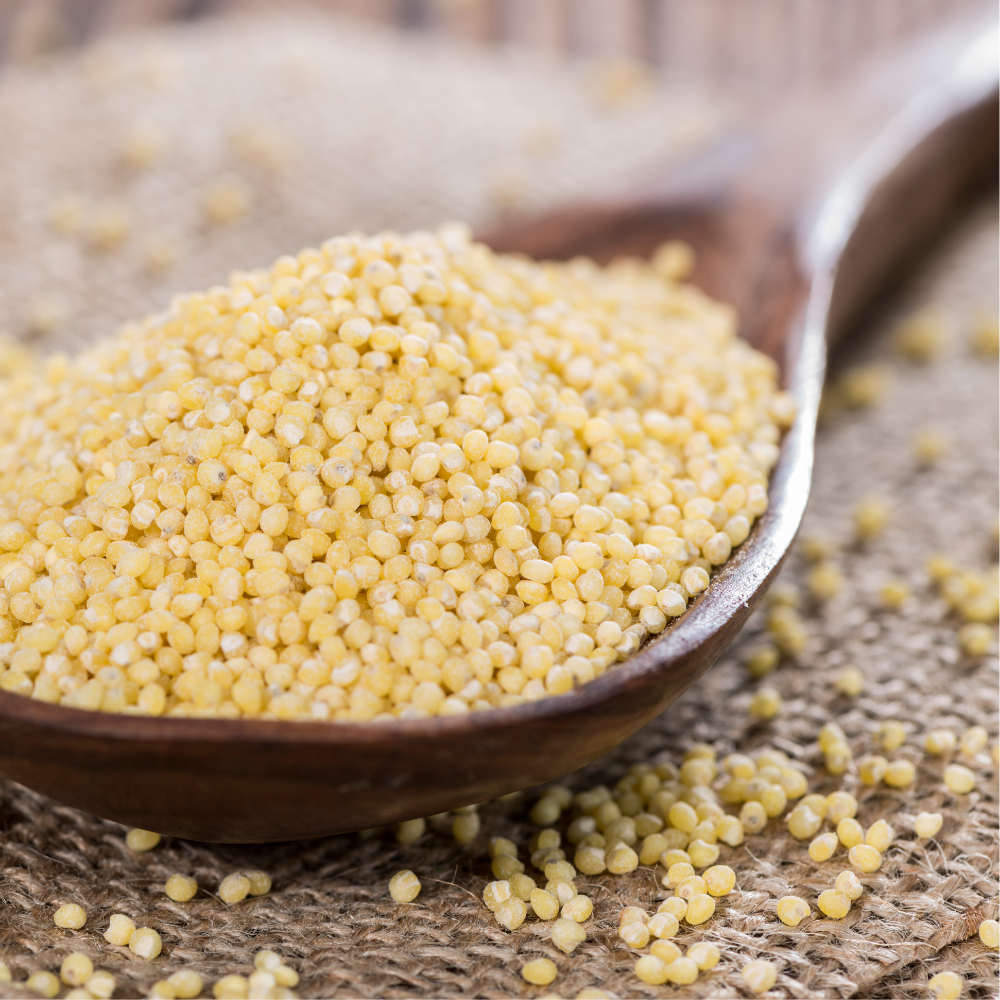In recent years, the resurgence of millet has taken the culinary world by storm. These tiny grains, collectively known as millets, have made a remarkable comeback in Indian kitchens after being absent for over four decades.
Thanks to the growing community of mindful eaters and nutritionists with a conservative approach towards food, millets have regained their rightful place and cemented their spot as a powerhouse of nutrition.
The word "millets" has become a perennial topic of discussion, attracting more attention than Bollywood gossip or politics.
In this article, you will get to know about benefits of Pearl millet, commonly known as Bajra, which is perhaps the most famous and widely available variety among millets.

|
TABLE OF CONTENTS
|
What is Pearl Millet?
You must be wondering what Pearl Millet is. Known as Bajra in Hindi and Bengali, Sajjalu in Telugu, Kambu in Tamil and Malayalam, Sajje in Kannada, and Bajri in Gujarati, Pearl millet is a widely grown millet in India and West Africa.
The Pearl Millet’s scientific name is Cenchrus americanus; it is also referred to as African Millet or Spiked Millet in different regions.
Archaeobotanical research suggests that Bajra cultivation dates back to 2000 BC, starting in the Hallur district of Karnataka.
Today, Rajasthan stands as the top producer of Bajra due to its ability to thrive in harsh climates, drought, and low soil fertility. Bajra's recent surge in popularity is mainly attributed to its high nutritional value.
Now let’s explore some amazing Bajra millet benefits.
5 Remarkable Pearl Millet Health Benefits
Pearl millet, or Bajra, offers numerous health benefits due to the versatility of Pearl millet nutrition.
Here are some of the key benefits of Pearl millet that help maintain our health:
1. Prevents Type 2 Diabetes
Diabetes is a chronic disease that requires proper blood glucose regulation for good health. Incorporating Pearl millet into a balanced diet can have diabetes-preventive benefits due to its:
- Unique composition: Pearl millet contains beneficial carbohydrates and dietary fibre that help regulate blood glucose levels.
- Digestible starch: Regularly including Pearl millet in your diet can lower the risk of developing diabetes due to its slowly digestible starch.
- Low glycemic index: Pearl millet has a low glycemic index, causing a slower and steadier rise in blood sugar levels compared to high-glycemic foods.
- Gluten-free alternative: If you are gluten sensitive, you can include Pearl millet, specifically in the form of Bajra roti with Methi.
Thus, by incorporating Pearl millet into your diet, you can take a proactive step towards better diabetes management and regulate your blood glucose levels effectively.
Pro Tip: To improve blood sugar control, try incorporating Bajra roti with Methi powder or leaves into your diet at least twice a week. This powerful combination enhances the Pearl millet benefits.
2. Pearl Millet Benefits for Weight Loss
If you are aiming to lose weight, incorporating Pearl Millet, or Bajra, into your diet can be beneficial, as this is one of the most important Pearl millet Benefits. This millet's protein helps build muscles and heal tissues. Its high protein level makes it a good alternative for vegetarians trying to cut carbs.
Including Pearl Millet in your meals can support your weight loss goals while providing a nutritious and satisfying option.
3. Prevents Polycystic Ovarian Syndrome
Another Pearl Millet Benefit is that it helps prevent Polycystic ovarian syndrome (PCOS). PCOS is a prevalent hormonal disorder affecting women of all ages, from teenagers to those in menopause.
This condition not only disrupts health but also impacts mood, causing fatigue and unwanted hair growth.
In addition to medication, weight loss, and strict dietary control, incorporating Bajra (Pearl Millet) into the diet can be beneficial.
Pearl Millet is rich in iron and fibre, which help reduce visceral fat, particularly around the abdominal region. This, in turn, regulates the menstrual cycle and prevents associated lifestyle disorders.
4. Makes the Heart Healthy
One of the most vital benefits of Pearl millet is that it makes a well-regulated diet essential for maintaining optimal heart health.
Pearl Millet is packed with magnesium and potassium, which play crucial roles in dilating blood vessels and promoting improved blood circulation.
Regular consumption of this wonder millet helps reduce LDL cholesterol, preventing the formation of arterial blockages.
Additionally, Pearl Millet varieties are rich in Omega-3 fatty acids and plant lignans, further contributing to heart health and overall well-being. Including Pearl Millet in your diet can be a valuable step towards maintaining a healthy heart.
5. Easy Digestion
Bajra aids digestion and prevents constipation, which is important for your general health. As a gluten-free cereal, it's great for Celiacs.
Due to its high insoluble fibre content, Bajra might help relieve constipation when eaten regularly. This fibre adds bulk to the stool, promoting regular bowel movements and preventing digestive issues.
In addition to Bajra, another millet variety called Little Millet also offers similar benefits for digestive health.
Incorporating these millets into your diet can support a healthy gut and alleviate constipation-related concerns.
Pearl Millet Nutritional Content
Here's a table outlining the Pearl millet nutritional value per 100 grams:
|
Nutrient |
Amount |
|
Energy |
1456 KJ |
|
Carbohydrates |
61.78 gm |
|
Protein |
10.96 gm |
|
Fat |
5.43 gm |
|
Fibre |
11.49 gm |
Source: https://pharmeasy.in/blog/12-nutritional-benefits-of-bajra-Pearl-millets/
Note: These values are approximate and can vary slightly depending on the specific variety and processing of the Pearl Millet.
Pearl Millet Uses
Pearl Millet has various uses in culinary preparations. Here are some common uses of Pearl Millet that you should be aware of:
- Flour: Pearl Millet flour is widely used in traditional Indian cuisine. It is used to make flatbreads like roti, bhakri, and bajra ki roti.
- Porridge: Pearl Millet can be used to make a nutritious and filling porridge. It is boiled in water or milk with jaggery or sugar and flavoured with cardamom or cinnamon.
- Pilaf: To make a pulao or pilaf, Pearl millet may be sautéed with vegetables, spices, and stock. Pearl Millet gives the dish a nutty and meaty flavour.
- Soups and stews: Pearl Millet can be added to soups and stews as a thickening agent. It imparts a wholesome taste and helps make the dish more satisfying.
- Snacks: Pearl Millet can be puffed or roasted to make crispy snacks. It can be seasoned with spices and enjoyed as a healthy alternative to fried snacks.
- Fermented dishes: Pearl Millet is used to make fermented dishes like fermented batter for dosa or idli, which are popular South Indian dishes.
- Animal feed: Pearl Millet is also used as a nutritious feed for livestock, particularly cattle and poultry.
Different Pearl Millet Recipes
Here are a few Pearl Millet recipes that will give you a good introduction to this wonderful grain:
1. Bajra Roti

Pearl Millet flour is protein-rich, providing up to 1.6 grams of protein per roti. It is also packed with vitamins, minerals, high fibre, zinc, magnesium, and phosphorus. Whole wheat flour, on the other hand, offers ample carbs and fibre, keeping you satisfied and curbing midday hunger pangs.
Ingredients:
- 1 cup Bajra flour (Pearl Millet flour)
- Water (as needed)
- Salt (to taste)
- Ghee or oil (for cooking)
Method:
- In a bowl, mix bajra flour and whole wheat flour with salt.
- Gradually add warm water and knead until the dough is smooth.
- Take a lemon-sized ball of dough and roll it on a flat surface with a rolling pin, dusting it with whole wheat flour if needed.
- Heat a tawa or griddle and place the rolled roti on it.
- Cook the roti on both sides until blisters appear, and it turns brown.
- Serve the hot roti with ghee, onion pieces, and vegetable curry.
2. Bajra Khichdi (Pearl Millet Pilaf)

Bajra Khichdi is a popular Indian dish made with Pearl millet and moong dal. It is a nutritious one-pot meal known for its simplicity and health benefits.
Bajra Khichdi is often consumed during the winter in North India as it provides warmth and energy. It is a healthy and soothing dish that is appreciated by people of all ages everywhere.
Ingredients:
- 1 cup Pearl millet (bajra)
- 1/2 cup moong dal (split yellow lentils)
- 1 onion, finely chopped
- 1 tomato, chopped
- 2-3 green chillies, chopped
- 1 teaspoon ginger-garlic paste
- 1 teaspoon cumin seeds
- 1/2 teaspoon turmeric powder
- Salt (to taste)
- Ghee or oil (for cooking)
- Fresh coriander leaves (for garnish)
Instructions:
- Wash and soak Pearl millet and moong dal for 30 minutes.
- Add cumin seeds to pressure-cooker ghee or oil.
- Chop onion, green chillies, and ginger-garlic paste when cumin seeds sputter. Sauté the onions until golden brown.
- Add the chopped tomatoes and cook until they become soft.
- Drain the soaked Pearl millet and moong dal and add them to the pressure cooker.
- Add 2 cups of water, turmeric powder, and salt.
- Pressure cook for 3-4 whistles until the millet and dal are porridge-like.
- Garnish with fresh coriander leaves, and serve hot.
FAQs
Is Pearl Millet suitable for individuals with gluten intolerance or Celiac disease?
Yes, Pearl Millet is a naturally gluten-free grain, making it a safe and nutritious option for those with gluten intolerance or Celiac disease.
Can Pearl Millet help improve digestion?
Pearl Millet is rich in dietary fibre, which promotes healthy digestion, prevents constipation, and supports overall gut health.
Does Pearl Millet provide any nutritional benefits?
Absolutely! Pearl millet benefits include the fact that it contains iron, magnesium, and B vitamins. These elements are needed for energy, immunological function, and general health.
What are pearl millet porridge benefits?
Pearl millet porridge is rich in nutrients, high in fiber, gluten-free, provides sustained energy, may help manage diabetes, supports heart health, aids weight loss, and is rich in antioxidants.
Is pearl millet good for health?
Yes, pearl millet is a healthy grain with various nutritional benefits. It is well known for its capacity to support excellent health and help maintain a diet that is well-balanced.
What is "bajra mamra"?
Bajra Mamra is a delicious and nutritious snack made with puffed pearl millet.
Bajra vs wheat, which is a better choice?
Bajra (pearl millet) is gluten-free, rich in nutrients, and has a lower glycemic index, making it suitable for those with gluten sensitivity or seeking blood sugar control. Wheat, on the other hand, is a good source of protein, versatile, and a common dietary staple, offering different nutritional benefits based on individual needs.
What are the Pearl Millet Flour Benefits ?
Pearl millet flour is rich in nutrients like iron, magnesium, and fibre, promoting digestive health, aiding in weight management, and preventing anaemia.
How Does Bajra Benefits & Contribute to a Healthy Diet?
Bajra, or pearl millet, is a nutritious grain with benefits such as supporting heart health, providing energy, and helping manage diabetes due to its low glycemic index.
What are different uses of pearl millet?
Pearl millet is used for food, flour, beverages, animal feed, traditional medicine, soil improvement.
Importance Of Pearl Millet In A Balanced Diet?
Pearl millet is essential in a balanced diet as it offers a gluten-free alternative, provides essential vitamins and minerals, and supports overall well-being with its nutritional content.
What are the Advantages of Pearl Millet in Your Meals?
Including pearl millet in your meals brings advantages like improved digestion, sustained energy levels, and enhanced nutrient absorption, contributing to a healthier lifestyle.
How Can Pearl Millet Roti Benefit Your Health?
Pearl millet roti, a popular Indian flatbread, is a nutritious choice due to its high fibre content, aiding in digestion, and its role in regulating blood sugar levels, making it a healthier alternative to wheat roti.
Conclusion
Bajra or Pearl Millet is a common summer crop in Rajasthan, India, and numerous African nations. Due to its gluten-free and nutritious nature, it is gaining popularity. You can enjoy the benefits of Bajra as it helps control blood sugar spikes, prevents chronic conditions, and promotes heart health.
During winter, consuming bajra can boost your lung power due to its anti-inflammatory properties, which can ease your breathing. You can try traditional dishes like Bajra roti and Bajre ki meethi poori, which are famous in Northern India.
However, if you have thyroid issues, it is advised against consuming Pearl millet, as it may further compromise your gland function. Remember to soak and cook bajra to avoid any digestive problems properly.
Experience the goodness of Bajra with Two Brothers India shop – your one-stop destination for quality Indian products. Order now and enjoy the nourishing power of Bajra!
Read more :
Brown Top Millet - Benefits, Uses, Nutrition, Recipes, and More










